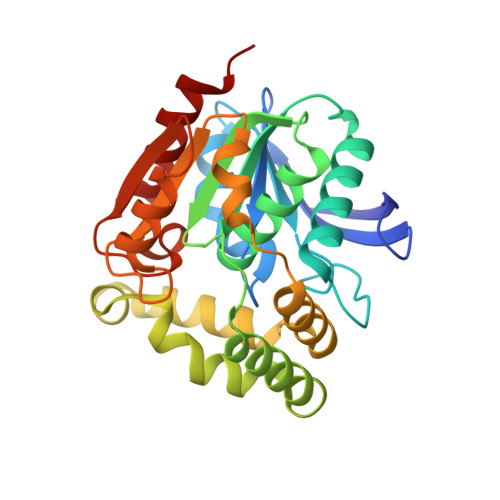Structural Studies of a Thermophilic Esterase from a New Planctomycetes Species, Thermogutta Terrifontis.
Sayer, C., Isupov, M.N., Bonch-Osmolovskaya, E., Littlechild, J.A.(2015) FEBS J 282: 2846
- PubMed: 26011036
- DOI: https://doi.org/10.1111/febs.13326
- Primary Citation of Related Structures:
4UHC, 4UHD, 4UHE, 4UHF, 4UHH - PubMed Abstract:
Thermogutta terrifontis esterase (TtEst), a carboxyl esterase identified in the novel thermophilic bacterium T. terrifontis from the phylum Planctomycetes, has been cloned and over-expressed in Escherichia coli. The enzyme has been characterized biochemically and shown to have activity towards small p-nitrophenyl (pNP) carboxylic esters, with optimal activity for pNP-propionate. The enzyme retained 95% activity after incubation for 1 h at 80 ˇăC. The crystal structures of the native TtEst and its complexes with the substrate analogue D-malate and the product acetate have been determined to high resolution. The bound ligands have allowed the identification of the carboxyl and alcohol binding pockets in the enzyme active site. Comparison of TtEst with structurally related enzymes provides insight into how differences in their catalytic activity can be rationalized based upon the properties of the amino acid residues in their active site pockets. The mutant enzymes L37A and L251A have been constructed to extend the substrate range of TtEst towards the larger butyrate and valerate pNP-esters. These mutant enzymes have also shown a significant increase in activity towards acetate and propionate pNP esters. A crystal structure of the L37A mutant was determined with the butyrate product bound in the carboxyl pocket of the active site. The mutant structure shows an expansion of the pocket that binds the substrate carboxyl group, which is consistent with the observed increase in activity towards pNP-butyrate.
Organizational Affiliation:
The Henry Wellcome Building for Biocatalysis, Biosciences, College of Life and Environmental Sciences, University of Exeter, UK.

















